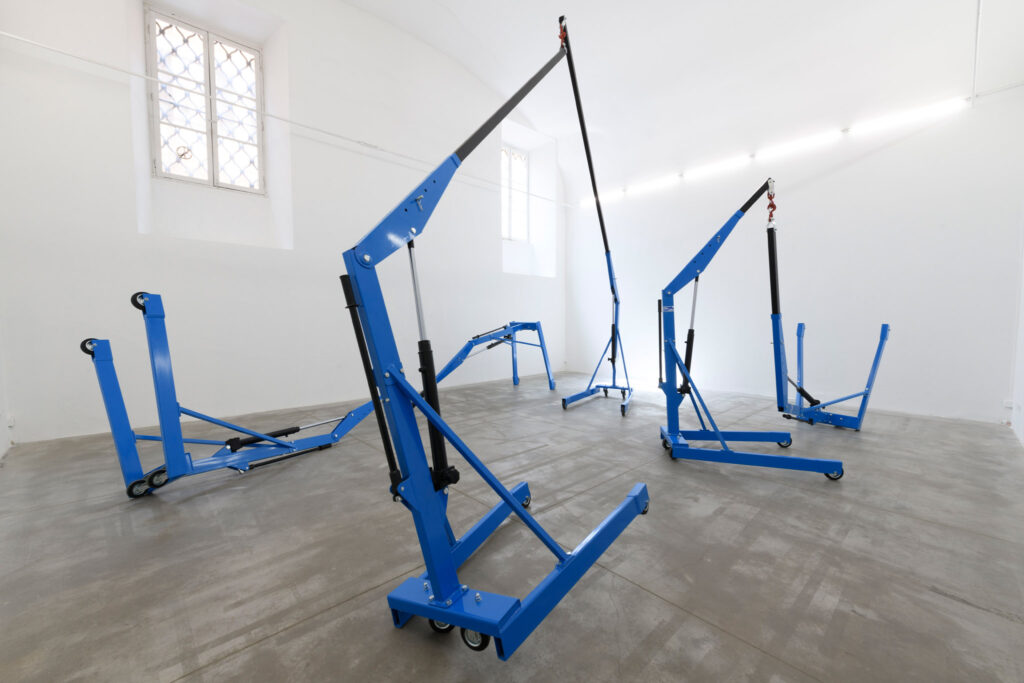Lucia Cantò – Ai terzi

Mostra di debutto a Monitor.
Comunicato stampa
Lo stare insieme aperti alla vita
Implica la fuoriuscita di un terzo
Solo
Parole estratte dagli scritti dell’artista Lucia Cantò (Pescara, 1995) che ci introducono alla sua mostra di debutto a Monitor e che sono rielaborazione linguistica e matrice della serie di opere site specific realizzate per la mostra Ai terzi. A questi terzi, è rivolto il moto di accoglienza da parte di una collettività di opere scultoree, composta da doppi. Nelle coppie di sculture e installazioni perfettamente combacianti, sono racchiuse le relazione di forza dei primi approcci, la tensione delle parti, il momento iniziale della scelta.
Non è la relazione di coppia quella che si vuole mettere in risalto in questo contesto, bensì, le relazioni che cercano di convivere all’interno di una collettività, i simboli e le implicazioni di tipo emotivo e sociale che ne derivano.
La ricerca artistica di Lucia Cantò è sorretta da un impianto intimo ma prorompente, e articolato in una intensa narrazione in cui scrittura e scultura si nutrono e sorreggono vicendevolmente. L’intimità della scrittura si fonde con il pensare e l’immaginare tridimensionale della scultura, che è metro di misura dell’artista rispetto a sé stessa e all’arte.
Una scrittura per certi versi ossessiva, che nonostante la sua natura solipsista, guida una ricerca dell’Io visibilmente aperta necessaria a stabilire una situazione di empatia con gli altri, a suggellare il passaggio dall’isolamento dell’Io alla prossimità del tu e del voi, a cui segue l’agire scultoreo.
La scrittura che in precedenti installazioni dell’artista, quali IO,TU (2019) era anche visivamente una struttura portante, una tensione visibile tra due macchine da scrivere, per imprimere i versi di amanti lontani, nel contesto della mostra corrente tesse una trama più nascosta, costruendo un dialogo sussurrato tra le numerose ‘opere coppia’, con il resto del mondo.
E se sostare negli spazi vuoti, lasciati liberi da questa collettività fatta di coppie, implicasse per noi terzi, seppur esclusi, il compito di entrare nelle viscere della relazione di coloro che si sono scelti, e coglierne le fragilità, i punti di equilibrio, il senso di appartenenza e reciprocità?
La mostra è accompagnata da un testo critico a cura di Cecilia Canziani, storica dell’arte e curatrice indipendente.
ENG
24 April – 4 June 2021
Being together, open to life
Implies the emergence of a third party
Alone
These abstract words by artist Lucia Cantò (Pescara, 1995) introduce us to her debut show at Monitor and act as a linguistic reworking and matrix of the series of site-specific works in her exhibition Ai Terzi. These terzi or third party are welcomed by an ensemble of sculptural pieces made up of doubles. The perfectly matched pairs of sculptures and installations encompass the strength of first approaches, the tension of parts, that initial moment of choosing.
It is not the relationship of the couple which is being emphasised, but the relationships which attempt to coexist inside a collectivity – the emotional and social symbols and implications which derive from it.
Lucia Cantò’s practice is upheld by an intimate but unbridled installation, and articulated in intense narration in which text and sculpture nourish and support each other. The intimacy of her writing fuses with the three-dimensional thinking and imagining of sculpture – the artist’s benchmark for herself and her art.
Her writing is at times obsessive but, despite its solipsistic nature, it guides us towards the search of a visibly open Self required to maintain a condition of empathy with others, to seal the transition from the isolation of the Self in its proximity to You and Us, followed by the sculptural act.
In previous works, such as IO, TU (I, YOU, 2019), text was also a visual backbone, seen in the physical tension between two typewriters imprinting verses by distant lovers. In Ai Terzi, the text weaves a more hidden plot, generating a whispered dialogue between the numerous coupled pieces and the rest of the world.
And what if pausing in these empty spaces, free from this collectivity of couples, implied for us third parties – even though excluded – the role of diving into the depths of the relationships between those who have chosen each other, to capture their frailty, their balance points, that sense of belonging and reciprocity?
The show is accompanied by an essay written by the art historian and curator Cecilia Canziani.



